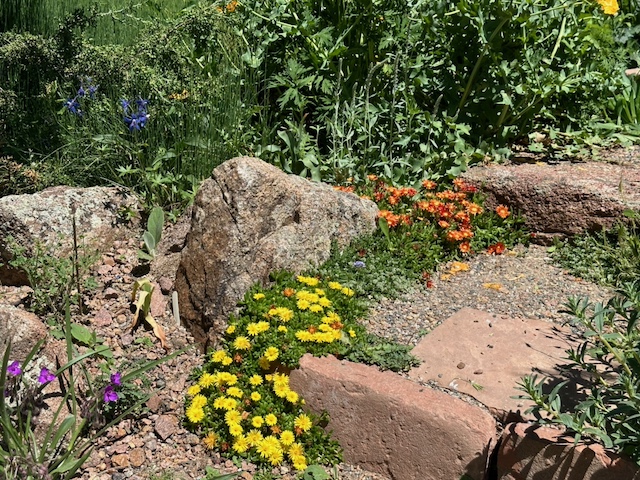Yes, I know it sounds cliche, but rock gardening in the Rockies really is a thing. Even bigger is CREVICE gardening in the Rockies.
I love to travel to visit gardens. Fortunately, my recent trip to Denver coincided with the Garden Conservancy’s Open Days. I happily spent a day driving across the Denver metropolitan area to visit gardeners who opened their gates and welcomed in garden-loving strangers – and several of those gardens featured a crevice garden.
What’s a crevice garden? It’s a garden built with vertical or slightly tilted stacks of flat rock that emulate natural rock formations. Between the rock are cracks and crevices filled mostly with sand. Kenton Smith and Paul Sprggs’ recent book called simply The Crevice Garden, describe crevice gardens as designed to “replicate the environmental conditions of mountain tops, deserts, coastlines, and other exposed or rocky places.”

Natural “crevice gardens” in the Rockies. Layers of rock naturally uplifted leave tiny gaps where bits of soil and organic matter accumulate – eventually enough for a seed to land and sprout.
The structure and medium of a crevice garden create the perfect habitat for an amazing array of mostly tiny, textural, fascinating alpine plants.
In one Open Garden, I met Mike and Eve Brawner, owners of Harlequins Gardens in Boulder. The couple explained how the crevices create microhabitats where plant roots have access to extra moisture that accumulates from condensation on the rock. Deep in those cracks, roots are protected from an atmosphere so dry, experts described it as “semi-arid” and “half-way to desert.” In winter, the rock pockets protect deep roots from cold as well.

Panayoti Kelaidis’ personal crevice gardens in Denver. The garden is a fascinating collection of plants ranging from cacti to flowering trees, shade and water loving plants to this very arid-adapted crevice garden that snugs up alongside his home.
That dry atmosphere means my lips are constantly chapped and my skin feels like tissue paper when I’m in Denver. Add the intense sunlight at a mile high elevation and you’ve got really challenging conditions for plants as well as for people.
My friend Panayoti Kelaidis introduced me to crevice gardening a few years back as we strolled Denver Botanic Gardens where he’s been Senior Curator and Director of Horticulture for decades. I’d read many of his blog posts about crevice gardens but it wasn’t until I visited one in person that I fully appreciated the art form. And so did my son, who has since converted his traditional grass front lawn to a fledgling crevice garden in Aurora, just outside Denver.

My son and his new crevice garden. He replaced a traditional front lawn with stacked rock and gravel, planted with a combination of succulent and non-succulent plants. This is the garden after only 8 months in the ground.
After a week in Denver, my husband and I drove home, first heading west through the mountains. At several stops along the way, we photographed mountain tops and exposed rocky places that clearly are the inspiration for crevice gardens.
And now, of course, I’m looking at my own garden, considering the opportunities for creating my own version of a crevice garden. Stay tuned!





